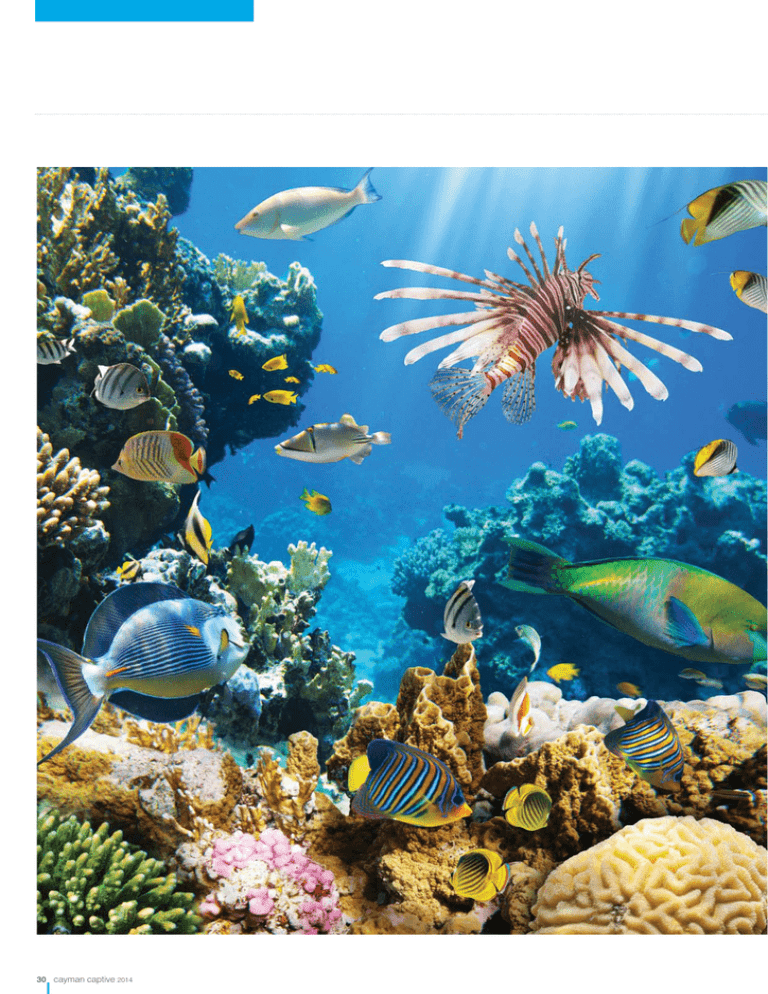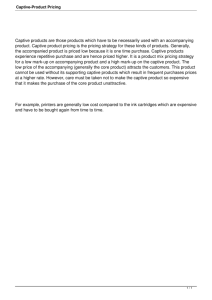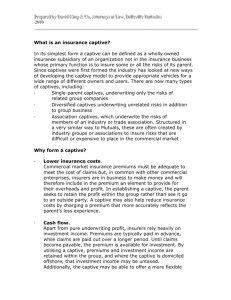01 Cover.indd - Atlas Insurance Management
advertisement

30 cayman captive 2014 Cayman Captive A fragile asset In the age of social networking and global media, a company’s reputation is under siege at every corner. The captive concept can provide valuable protection to this intangible, but invaluable, asset. any a great thinker has opined on the value of a good reputation (or, in some cases, a bad one), but first century writer of maxims Publilius Syrus said it best as far as businesses are concerned: “A good reputation is more valuable than money.” M Tom Stokes, principal at JLT, said: “Several global consumer products companies have experienced local issues in far-flung areas concerning contamination, tampering and other similar issues. Those that operate through franchise structures could lose lucrative outlets to competition.” As social networks expand their reach and the media’s coverage continues to seep into the furthest reaches of the globe, a corporation’s reputation is increasingly at risk. Social media snafus can happen instantly: shrugging off an issue with a supplier in one far-flung location can have serious implications for the bottom line at home. A single leak to the media is suddenly sent to inboxes around the world. But, despite the increasing risk and awareness, finding coverage for reputational risk in the traditional insurance markets can be a struggle. Captives have already shown themselves to be valuable tools for covering complex and company specific risks, and their connection with emerging risks such as cyber make captives and reputational risk a perfect match. According to a report by The Economist, “Reputation is a prized—and highly vulnerable—corporate asset. The preoccupation with it stems from the fact that executives now see reputation as a major source of competitive advantage.” According to Eric Fauerbach, CEO of Alterra Risk Management, “Surveys have shown that most companies believe information and advice on how to manage reputational risk is hard to find. Most captive owners simply are not aware that their captive may provide a solution to reputational risk. Many captive advisers and risk managers could do a better job of educating clients on potential non-traditional captive solutions.” Difficult to quantify, highly specific and absolutely essential, reputation is an ideal risk to run through a captive insurance programme. A potential solution Proviti, a risk and consulting firm, defines reputational risk as ‘the current and prospective impact on earnings and enterprise value arising from negative stakeholder opinion’. According to Jonathan Copulsky of Deloitte Consulting, reputational risk is a far bigger deal today than it was five or 10 years ago. He wrote in a report: “We used to view risk through two primary lenses: impact and likelihood. Now we’ve added a new dimension—velocity. In today’s highly connected environment, reputational damage can spread at lightning speed. “In a matter of minutes, a company could have to deal with 5,000 new complaints from highly connected consumers. That’s a major change from only a few years ago—and one that holds serous new implications for managing risk.” Jeff Ellington, responsible for underwriting management at Atlas Captives, told Captive International that he discusses reputation risk with all his enterprise risk captive clients. He said, “With the number of white papers and articles addressing the exposure, and as the exposure becomes more and more predominant, its importance will continue to increase.” “Captive managers are looking to drive insuring reputation risk through a captive forward as a concept because there is an awareness issue,” said Fauerbach. “Now, as captive mangers are starting to explore the opportunities to a greater degree, they’re starting to bring the concept to captive owners. Several captive owners may have brought up the possibility in the past and it just wasn’t a feasible option then—but now it is.” cayman captive 2014 31 “HAVING EMERGENCY FUNDS AVAILABLE TO ADDRESS LOSS ISSUES IMMEDIATELY CAN HELP CONTAIN A SITUATION AND PREVENT IT FROM GETTING OUT OF CONTROL.” A new arrangement With a factor as ambiguous as reputation it takes a solid plan of action to run a valid programme through a captive. Ellington starts at the beginning—with a careful analysis of his client’s exposure. It’s important, Ellington said, to examine those exposures that are unique to your company. This includes the competitive environment, how exposed the company is to regulation (an important factor, according to a report by The Economist, which found that failure to comply with legal or regulatory obligations was seen as the biggest threat to reputation) and also how exposed a company is to the global media and the ever-watchful public eye. In the case of a large loss, he said, innovative thinking could provide captive owners with extra protection. He explained, “More interesting is the idea of having the captive fund for acceptable layers of risk— an amount based on the balance sheets of the captive and the parent—and then to participate in a sidecar vehicle that would access catastrophe bond cover for the truly catastrophic.” Gradual evolution While the opportunity to place reputation risk through captives is exciting, it is also a concept that is still in development. As with every emerging risk, there are elements that must be considered before Ellington said: “We as captive managers need to help our clients become aware of how others perceive their company so that it can be measured. In addition we try to quantify the extent of the financial impact from reputational risk.” moving forward. Social networking sites are also a major concern. Fauerbach said, “As companies get more involved in the channels of social media it expands their reputational risk exposure. As soon as you have employees involved in different social media outlets you’re exposing yourself.” coverage can both overlap with reputational damage coverage. What Social media problems seem to be to companies what sex scandals are to politicians: high profile and, depending on how you deal with them, easily laughed off or absolutely devastating. KitchenAid and Microsoft were both caught with egg on their faces when employees posted highly politicised tweets to company accounts, thinking they were logged into their personal profiles, but both escaped fairly unscathed. Not so for US restaurant franchise Applebee’s, which terminated an employee for posting on a social media site and then found itself deleting tens of thousands of abusive messages from its own Facebook page. majority of captives it is perhaps best suited for larger companies. Avoiding these pitfalls, Ellington says, is all about communication and education. “My firm has contracted with a public relations firm that specialises in crisis communications. They’re there 24/7. Education is also important, and this PR firm provides access to educational resources.” I believe that this will be a major area of expanded use for captives. In the case of an event, a well-prepared captive can be a valuable resource. Stokes explained how such a captive might function. He said, “Captives should be available to fund the smaller, more easily contained losses, as risk transfer can be limited and expensive. Having emergency funds available to address loss issues immediately can help contain a situation and prevent it from getting out of control.” 32 cayman captive 2014 According to Ellington, one of these considerations is the possibility of coverage overlap. “For instance,” he said, “cyber risk—particularly when you’re dealing with extortion threats—and product recall we find is that often the reputational damage—considered secondary to the primary risk—can be more costly.” Fauerbach pointed out that while this kind of coverage can suit a “The best use is made by larger corporations who have more broad reputational exposures, but there certainly are pockets within the small and mid-size arenas that make sense, particularly in areas where the reputation is built on maybe one specific product line with a strong brand image in the middle market.” But soon enough this could be a more universal concern. Stokes pointed out: “As companies continue to expand into the global market It is yet another example of captives being used to address complex exposures far beyond the traditional and predictable exposures of the past.” Ellington concluded: “With the evolving social media and global communications network this concept will be looked at more and more by businesses as they consider their individual risks and how to cover them, and also how to be more proactive in managing risk to prevent damage to their company. There is more and more press every day— that’s something on the forefront. Business owners consider this one of the most—if not the most—important areas that they need to address.” O




